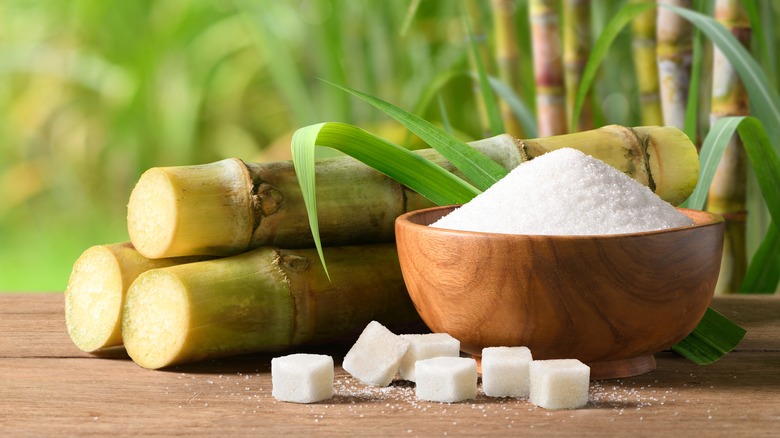Discovering the Distinctions in Usages and Benefits In Between Beet Sugar Vs Cane Sugar
In the culinary globe, the selection between beet sugar and cane sugar is not just about sweetness however entails a nuanced consideration of flavor, application, and influence. While both sugars stem from different plants, each undergoes one-of-a-kind production procedures that subtly influence their features and viability for numerous meals.
Beginnings and Manufacturing Procedures of Beet and Cane Sugar

Walking stick sugar, on the other hand, comes from the sugarcane plant, a tropical yard indigenous to Southeast Asia however now cultivated in exotic zones worldwide - beet sugar vs cane sugar. The production of cane sugar begins with the harvesting of cane stalks, which are squashed to release the juice.

Nutritional Content and Health And Wellness Considerations

When comparing the nutritional content of beet sugar and cane sugar, it comes to be noticeable that both kinds essentially offer the same calorie worths, with about 16 calories per tsp and no substantial nutrient variety. Each is composed almost totally of sucrose, which is a straightforward carb that uses quick power however lacks vitamins, minerals, or fiber. This resemblance encompasses their effect on health, specifically concerning blood sugar degrees. Both sugars, when consumed over, can add to raised blood sugar levels, a risk variable for diabetic issues and various other metabolic conditions. Furthermore, too much intake can lead to weight gain and dental issues, as both sugars are similarly cariogenic, advertising tooth decay. From a health viewpoint, moderating intake of any kind of sort of sugar, whether from beet or cane, is suggested to prevent these possible adverse effects on health. Thus, neither holds a distinctive advantage over the other in regards to wellness benefits.
Taste Profiles and Culinary Applications
Despite their similar chemical structures, beet sugar and cane sugar differ subtly in flavor, which can influence their use in different cooking contexts. Walking cane go to website sugar often carries a hint of molasses, also in its polished kind, offering a cozy, caramel-like touch that boosts baked items, coffee, and chocolate-based dishes. This mild molasses taste is specifically valued in the cooking market for adding depth to sweets and breads. On the other hand, beet sugar is defined by its highly refined, neutral taste, making it a functional sugar that does not change the flavor accounts of recipes. This nonpartisanship is especially beneficial in delicate dishes, such as light breads, creams, and some sauces, where the inherent tastes of various other components are intended to stand out. Subsequently, cooks and food manufacturers might pick one kind of sugar over the other based upon the preferred flavor end result of their culinary creations.
Environmental Influence and Sustainability
While both beet and cane sugars are obtained from plants, their ecological impacts vary significantly due to the unique approaches of cultivation and handling needed for each. Sugar beet growing usually involves substantial automation, which can enhance nonrenewable fuel source consumption and carbon discharges. Beets can be grown in cooler environments and need much less watering, possibly reducing water usage compared blog to sugarcane. Sugarcane, on the other hand, is commonly expanded in exotic areas where it relies heavily on irrigation and a longer growing period, enhancing its water footprint.
Furthermore, the processing of sugarcane frequently produces a significant amount of waste, consisting of bagasse, which, although useful as biofuel, frequently contributes to air pollution if melted inefficiently. Sugar beet handling makes use of even more of the raw materials, resulting in much less waste. Both sectors deal with difficulties in minimizing their environmental footprints, yet continuous advancements in agricultural practices and waste monitoring are intending to improve sustainability.
Economic Variables Affecting the Sugar Sector
The economic characteristics of the sugar industry are dramatically influenced by international market needs and trade plans. Factors such as tolls, aids, and international profession arrangements play vital duties fit the affordable landscape. As an example, in regions where sugarcane or sugar beet manufacturing is subsidized, producers may have a monetary benefit that enables them to use reduced rates on the global market. This can develop disparities in earnings and market accessibility for producers in countries without such aids.
In addition, fluctuations in global demand for sugar, influenced by nutritional patterns and industrial use in foodstuff, directly impact costs and production levels. beet sugar vs cane sugar. Weather condition problems likewise play an essential function, as they can significantly impact crop returns and, consequently, the supply chain. This irregularity presents a degree of visit homepage financial uncertainty that can cause investment volatility in sugar production sectors, influencing choices from growing to market method
Final Thought
In final thought, both beet and cane sugar have unique qualities that fit different cooking needs. While cane sugar conveys an abundant flavor perfect for enhancing baked goods, beet sugar's nonpartisanship is ideal for lighter dishes.